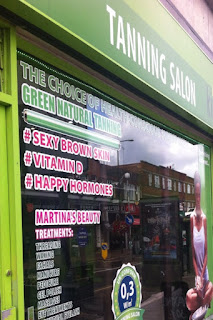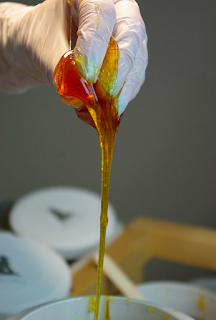‘I didn’t even notice you’d had a spray tan done’: The role of distinction in the production of femininities in the beauty salon.
At the time of year when we're encouraged to get "glowing holiday skin", we revisit this thoughtful exploration of the spray tan from 2016.
3. Where
possible, always shave or wax at least 24 hours prior to a spray tan
appointment, as hair removal after a spray tan will remove the tan.
6. Try to
avoid activities that involve excessive perspiring for 12 hours after a spray
tan.
7. Try to
avoid activities that naturally exfoliate the skin – such as baths and
chlorinated pool swimming – for at least 12 hours after your spray tan.
12. Exfoliate
from head to toe the day prior to a spray tan, paying particular attention to
areas such as your knees, elbows and ankles.
21. After a
shower, try to gently pat your skin dry and avoid vigorous rubbing when towel
drying.
Pre-twentieth century, ‘pale skin was often perceived as a
mark of beauty, wealth and refinement’ (Martin et al. 2009: 2140) and ‘a tan
was considered a mark of the lower classes’ (Segrave 2005: 5). However, since
the 1920s, amongst white Europeans, this has been reversed with a tan becoming
desirable and even worked upon: taking up sunbathing as a hobby, using sun beds
under UV light or, increasingly, turning to artificial tanning products to
achieve the desired look. In 2011, the
BBC reported that ‘retail
analysts Mintel estimate that Britons spend £35m a year on fake tan products
from shops, and spend millions more on lotions and sprays in salons’. During a half hour trip to the beauty salon,
you can have this marker of health, wealth, leisure and style (and indeed class)
literally sprayed onto your body. Except,
if it is too orange, too obviously artificial: the glamour of the (fake) tan
‘easily slid[ing] into tartiness’ (Holliday and Sanchez Taylor 2006: 192) or
‘tackiness’ (Skeggs 1997: 76). In my
research into the diversity of beauty treatments in London, one of my white,
middle-class respondents commented that a spray tan 'should look like you've
just returned from a week in Ibiza'. Consider the difference between this
and, as The Sun describes, ‘the
Towie ‘you’ve been Tango’d’ look’.
In this post I want to explore ethnographically
having a spray tan in order to consider not only, in Bourdieu’s terms, ‘the
sign-bearing, sign-wearing body’ in which ‘the body is the most indisputable
materialization of class taste’ (1984: 192, 190) but to elaborate on this to
think through how meaning, materiality, emotion and sensation are equally
entangled in the production of femininities in the beauty salon.
Before attending a wedding in
early August, I have decided to have a spray tan to even out my tan lines and
to look good in my wedding attire. I have
started writing this blog post on the morning of my appointment and will
continue during the day as I ‘fake bake’ at home: an experiment in ‘live
sociology’ (Back and Puwar 2012).
Photo 1: #sexybrownskin
…
I have followed the instructions:
I have depilated, exfoliated and moisturised, I have planned the clothing I will
wear so as not to rub the tan and I am relieved it’s not raining (not the case
on the occasion of my first spray tan when I arrived at the salon with a huge
umbrella, a change of clothes, a baseball cap and a waterproof jacket –
desperately trying to avoid getting wet and streaking the tan which would have
given away its artificiality). The
labour that goes into the spray tan, into avoiding streaking, rubbing, smudging,
tell-tale dry patches, and uneven colour, is labour to ensure that the artifice
of the tan remains invisible.
Photo 2: Tell-tale orange flecks on my palm
…
As I leave the salon after the
spray tan and wait for the bus, I am feeling faintly ridiculous, as if my
suddenly-very-brown skin is extremely obvious and the other people at the bus
stop will surely know. I find myself
looking for other tanned people as if to reassure myself that this could pass
as natural. Despite wearing loose
clothing, as I walk along I can feel my trousers sticking to my inner thighs
and I worry they are going to make the tan smudge. I am also feeling slightly sticky with a not
unpleasant but vaguely chemically woody smell emanating from my skin, a scent
that will linger for as long as the ‘tan’.
Photo 3: The sleeve of the jacket
I wore home from the salon
…
Arriving at home, I now have to
wait between 2 and 6 hours (depending on how ‘tanned’ I want to be (look)
before showering. I have decided to
‘bake’ for around 5 hours as, of course, I want the tan to be noticeable
however I am also anxious that this will be too long resulting in an unnatural
orangey colour. I worry that leaving the
colour to develop for too long will not only mark the tan as artificial but
also distinguish me as the sort (class?) of person who uses fake tanning
products.
Photo 4: Beginning to wash off
the ‘tan’
…
4 ½ hours have passed and I
decide to wash the colour off, I shower until the water runs clear. Looking down at my body at first I am
disappointed, there doesn’t seem to be any noticeable effect. Then looking in a mirror, I begin to worry
that I am looking exactly the shade of orange that I had hoped to avoid; in
another room, in another light, I look like I have a healthy glow. Again, walking down to the shops, I appear at
first to have overdone it and then to look ‘natural’, are those admiring
glances? or looks of ridicule? (or more likely neither).
Photo 5: A panicking reaction
…
Through recording my own
experience (as a white, middle-class, cis-gendered woman) of getting a spray
tan done, I hope to have opened up a way of thinking about the production of
femininity, and in this case, the production of a purportedly ‘respectable’
femininity – ‘white, desexualised, hetero-feminine and usually middle-class’ (Skeggs
1997: 82) – as more than the meanings projected onto and by a body, Bourdieu’s
‘sign-bearing, sign-wearing body’.
Rather I have sought to highlight the spray tan as a process in which both
meaning and materiality are inextricably entangled. It is in this ethnographic exploration of a spray
tan, the account of the (invisiblised) labour that goes into it, the tanning
product itself as a lively force, my anxiety not to be misrecognised as some
‘tasteless’ Other, and my reactions to the ‘finished product’, that the
production of (classed) femininities has revealed itself as a thoroughly material,
sensorial, embodied and affective process.
References:
Back, L.
and Puwar, N. (2012) ‘A manifesto for live methods: Provocations and capacities’ in Back, L.
and Puwar, N. (eds.) Live Methods,
Malden and Oxford: Wiley-Blackwell/The Sociological Review.
Bourdieu,
P. (1984) Distinction, London:
Routledge.
Holliday,
R. and Sanchez-Taylor, J. (2006) ‘Aesthetic surgery as false beauty’, Feminist Theory 7:2, 179-195.
Martin,
J.M, Ghaferi, J.M, Cummins, D.L, Mamelak, A.J, Schmults, C.D, Parikh, M,
Speyer, L-A, Chuang, A, Richardson, H.V, Stein, D. and Liégeois, N.J. (2009) ‘Changes
in skin tanning attitudes: Fashion articles and advertisements in the early
twentieth century’, Public Health Then
and Now 99:12, 2140-2146.
Segrave,
K. (2005) Suntanning in the
Twentieth Century, Jefferson: McFarland and Company Inc.
Skeggs, B.
(1997) Formations of Class and Gender:
Becoming Respectable, London: Sage.
Biography:
Louise Rondel is a PhD student in
the department of Sociology at Goldsmiths, her interests include: production of
space; bodies-cities; promises of monsters; be(com)ing beautiful; haptic
geographies; space invaders.
Contact:
@LouiseRondel
l.rondel@gold.ac.uk








oh yeah
ReplyDeleteWhat a lovely scholarly vignette, thank you. One comment--I think that the class elements of tanning are different in different places. Coming from Australia to live in the UK 18 months ago I was shocked at the tanning that goes on here. In Australia it's rare to have someone of any age or class deliberately going brown. This is because of huge anti-skin cancer campaigns that began in the 80s and are ongoing. Tanning machines are illegal in Australia! There is a small market in fake tanning products but people with 'real' tans are mostly frowned upon, and letting your child get a tan is considered virtually abusive.
ReplyDeleteWhat a lovely scholarly vignette, thank you. One comment--I think that the class elements of tanning are different in different places. Coming from Australia to live in the UK 18 months ago I was shocked at the tanning that goes on here. In Australia it's rare to have someone of any age or class deliberately going brown. This is because of huge anti-skin cancer campaigns that began in the 80s and are ongoing. Tanning machines are illegal in Australia! There is a small market in fake tanning products but people with 'real' tans are mostly frowned upon, and letting your child get a tan is considered virtually abusive.
ReplyDeleteMeredith, thank you for reading and for your comment. My wider research project is looking into the relationship between beauty practices and place so I am always interested to hear about how these practices differ (and have different implications) in different geographic contexts and how they travel as people move across the world. I wonder if in the UK, the increase in fake tanning products (as opposed to UV lamps etc) is related to more awareness surrounding the risks of being in the sun, however given that I have seen spray tans advertised as 'a pre-holiday tan' (i.e you then go and sit on a beach) I think not. I would also be interested to know why fake tanning products aren't popular in Australia, perhaps even looking like you *might* have a real tan puts people off?
DeleteTechnology is developing so fast that every day we get to see a glimpse of it. People don't have time to do stuff as they already are tangled. Because of the technology you can order services online just like students hire assignment writing services in Dubai to avail assistance from professionals to solve their academic hurdles and finish tasks within the time limit.
ReplyDelete